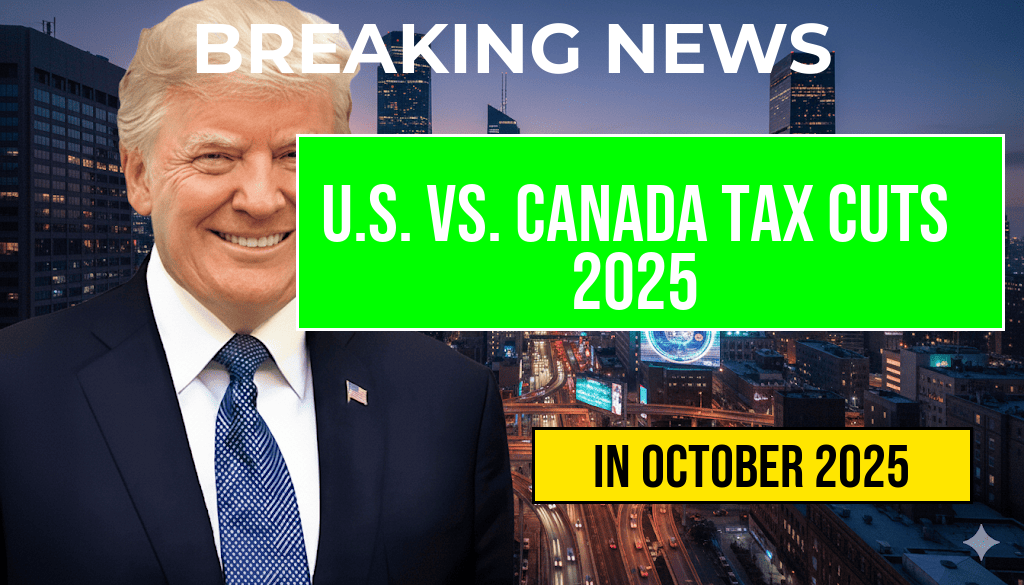As 2025 unfolds, the contrasting approaches to personal tax relief in the United States and Canada highlight significant differences in government policy and economic strategy. U.S. taxpayers are experiencing an average tax cut valued at approximately $3,752, while Canadian residents are benefiting from tax reductions totaling around C$5,200. These figures reflect broader fiscal policies designed to stimulate household disposable income, but they also reveal divergent priorities and economic contexts between the two nations. This comparison offers a comprehensive look at how tax cuts are shaping consumer finances, government revenue, and economic growth prospects across North America.
Understanding the Framework of 2025 Tax Cuts
United States: Targeted Relief Amid Fiscal Constraints
The United States’ tax cuts for 2025 primarily focus on middle-income households, with adjustments aimed at reducing the tax burden and encouraging consumer spending. The Tax Cuts and Jobs Act of 2017 laid the groundwork, and subsequent modifications have sought to sustain growth while addressing deficits. The current policies include increases in standard deductions, adjustments to income brackets, and targeted credits for families and small businesses. According to estimates from the Congressional Budget Office, these measures translate into an average tax savings of around $3,752.
Canada: Broad-Based Tax Reductions with a Focus on Income Growth
Canada’s 2025 tax policy emphasizes broader income brackets and specific credits to bolster middle-class prosperity. The government has implemented cuts across federal income taxes, including reductions in marginal rates and increased thresholds for taxable income. These efforts are designed to enhance disposable income for a wider segment of the population, with an average benefit estimated at C$5,200. Notably, Canada’s approach integrates with provincial policies, which vary regionally but collectively aim to create a more favorable environment for economic mobility, as detailed by the Canada Revenue Agency.
Comparative Analysis of Impact and Policy Goals
Magnitude of Tax Benefits
| Country | Average Tax Cut | Equivalent in USD |
|---|---|---|
| United States | $3,752 | $3,752 |
| Canada | C$5,200 | $3,860 (approximate, based on 2025 exchange rates) |
The comparison reveals that Canadian tax cuts, when translated into U.S. dollars, slightly surpass those in the U.S., reflecting Canada’s broader income thresholds and more expansive relief measures. This difference underscores a policy orientation that favors widespread benefits over targeted relief.
Policy Objectives and Broader Economic Contexts
The U.S. approach aims to stimulate consumer spending and investment within a constrained fiscal environment, balancing tax relief with deficit management. Conversely, Canada’s strategy seeks to reinforce middle-class stability and promote economic mobility, supported by a more extensive social safety net and regional policy variation. Both countries recognize the importance of tax policy as a tool for economic growth, but their methods and emphases differ significantly.
Implications for Households and Economic Policy
Household Finances and Consumer Behavior
- United States: Households see an average annual saving of approximately $3,752, which can influence discretionary spending, savings rates, and investment behaviors.
- Canada: The average benefit of about C$5,200 (roughly $3,860 USD) provides similar disposable income boosts, potentially impacting housing markets, retail sectors, and personal savings.
Government Revenue and Fiscal Health
While tax cuts aim to bolster economic activity, they also pose challenges for government revenue streams. The U.S. faces ongoing debates over deficits and debt levels, balancing relief with fiscal sustainability. Canada’s policies, supported by a relatively more stable fiscal position, allow for broader relief without immediate concerns over revenue shortfalls. These dynamics influence future policy decisions and economic resilience.
Looking Ahead: Policy Trends and Cross-Border Considerations
As both nations navigate post-pandemic recovery and inflationary pressures, their tax strategies will likely evolve. The U.S. may prioritize targeted relief to address income inequality and stimulate specific sectors, while Canada might continue emphasizing broad-based income support. Cross-border economic integration and migration patterns also add complexity to fiscal planning, with tax policies playing a crucial role in shaping competitive advantages and living standards.
For further insights into tax policy developments, consult Wikipedia’s overview of U.S. tax policy and Canada’s taxation framework.
Frequently Asked Questions
What are the main differences between U.S. and Canadian tax cuts in 2025?
The primary differences lie in the amounts of tax cuts offered, with the U.S. providing approximately $3,752 and Canada offering around C$5,200. Additionally, the scope and targeted benefits of these tax cuts vary based on each country’s economic policies and fiscal strategies.
How does the international perspective influence the comparison of U.S. and Canadian tax cuts?
The international perspective highlights the relative generosity and impact of each country’s tax policies on residents and businesses, enabling a comprehensive understanding of how these cuts position the U.S. and Canada in the global economic landscape.
What factors contribute to the differences in tax cut amounts between the U.S. and Canada?
Differences are influenced by government fiscal policies, economic priorities, and taxation structures. Canada’s higher tax cuts in C$ may reflect targeted efforts to stimulate specific sectors or address income disparities, while the U.S. focuses on different economic objectives.
How might these tax cuts impact residents and businesses in the U.S. and Canada in 2025?
The tax cuts are expected to boost disposable income for residents and encourage investment among businesses, potentially leading to economic growth. The magnitude and distribution of benefits will depend on the specific design of each country’s tax policies.
What is the significance of comparing U.S. and Canadian tax policies from an international perspective?
This comparison provides valuable insights into regional economic strategies, policy effectiveness, and global competitiveness. Understanding these differences helps policymakers and investors gauge the relative advantages of each country’s fiscal approach in 2025.








